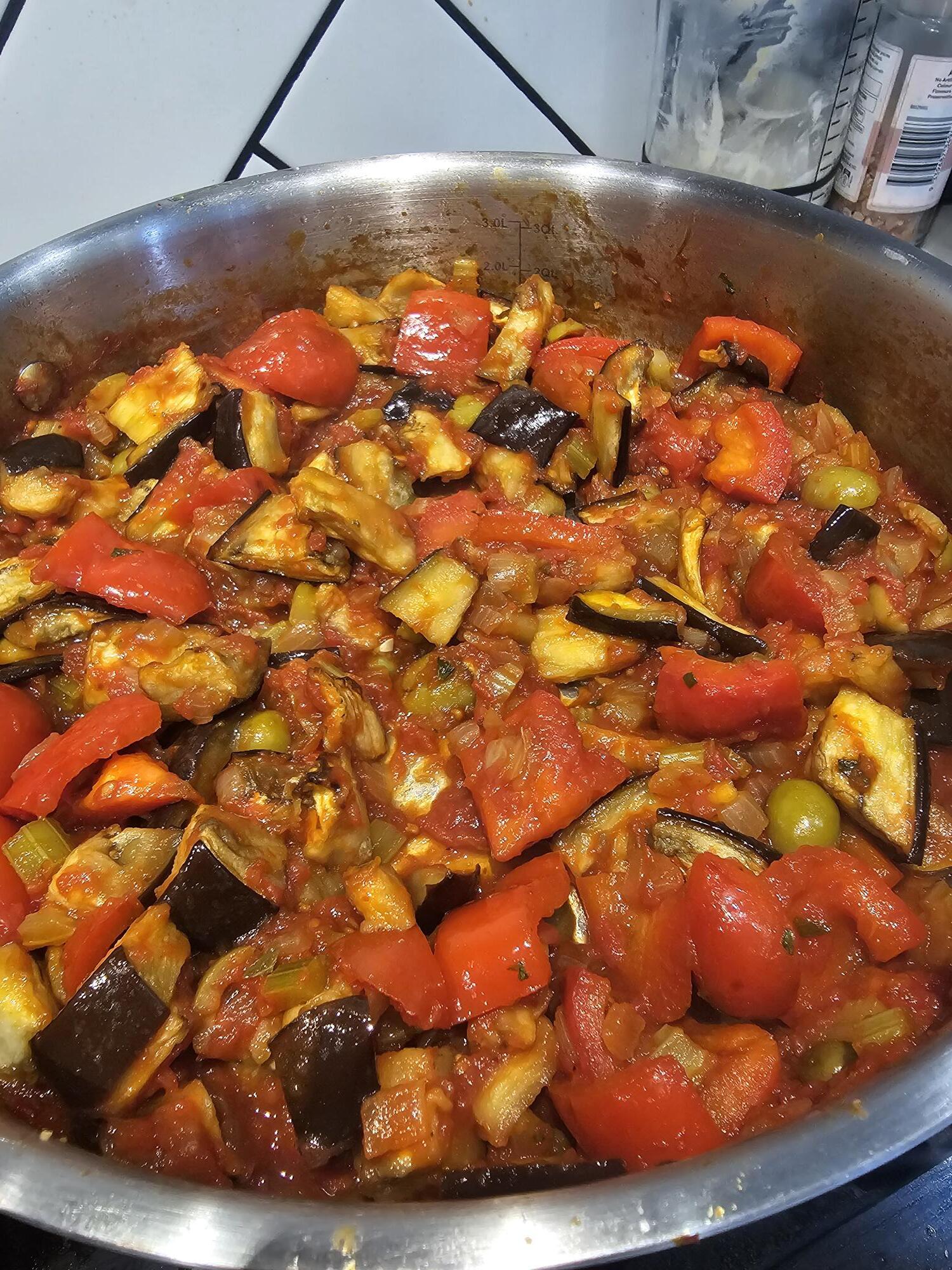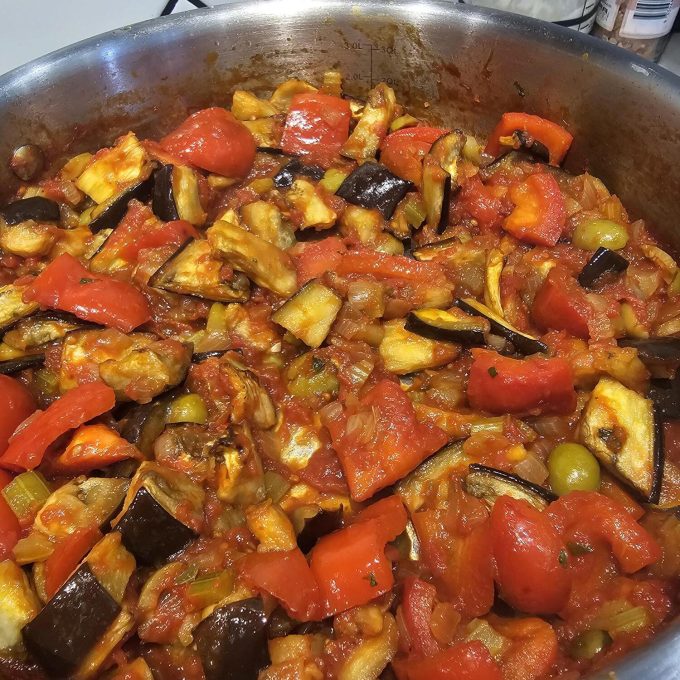Caponata

There are certain dishes that have the power to transport us—not just to a different place, but to a different time. Caponata is one of those dishes for me. It carries the memories of my childhood, the smell of mum’s kitchen, and the deep connection to her Sicilian roots, even though I grew up thousands of kilometers away in Australia.
Mum, a chef through most of my childhood years, never followed a recipe to make Caponata. It was in her blood, just as it was in her parents before her. I remember standing beside her in the kitchen as she cooked with such heart, the rich aroma of onions, olive oil and garlic filling the air. She always cooked with such flow and grace, allowing the ingredients to speak for themselves—the perfect balance of sweet and sour, the depth of flavour with the olives and capsicum and the way eggplant softened in the sauce. Yum!
For our family, food was, and still is about connection. Caponata was a dish that transported us to the rustic kitchens of Sicily where my grandparents once cooked. It was a taste of the old world, served with crusty bread at the dinner table, transporting us back to a place mum longed to return but rarely visited.
The beauty of Caponata is that it’s vegan by default —pure, humble ingredients turned into something magical. It’s the kind of dish that gets better with time, soaking in its own glory, perfect as a snack, a side, or a meal on its own. It’s a dish that reminds me who I am, where I come from, and the stories that live in every bite.
Now, I get to share this beautiful tradition with you. Let’s make Caponata.
Ingredients
What Makes This Dish Great?
- Eggplant: A soft and creamy vegetable that soaks up flavours. It’s high in fiber and rich in antioxidants, making it great for digestion and overall health.
- Extra Virgin Olive Oil: Adds a rich taste and helps bring out the flavours of the other ingredients.
- Brown Onion: Gives the dish a deep, savoury base flavour.
- Celery: Adds a slight crunch and fresh taste.
- Red Capsicum: Adds a sweet, slightly smoky flavour and a bright colour.
- Salt & Black Pepper: Enhances all the flavours in the dish and balances the taste.
- Crushed Tomatoes: Forms the rich, tangy base of the sauce. Full of lycopene, an antioxidant that’s good for the heart.
- Green Olives: Adds a briny, salty taste that makes the dish more flavourful.
- Maple Syrup: Balances out the acidity of the tomatoes and vinegar with a hint of natural sweetness.
- Red Wine Vinegar: Gives the dish a slight tangy kick and helps bring all the flavours together.
- Dry White Wine: Adds depth and richness to the sauce as it cooks down.
- Fresh Parsley: Brightens up the dish with fresh, herby flavour.
- Roasted Pine Nuts: Adds a nutty crunch and a hint of sweetness.
How to Make This Recipe
Step 1: Roast the Eggplant
Preheat your oven to 180°C (350°F). Wash the eggplant and cut it into large 4cm cubes, keeping the skin on. Spread the pieces on a baking tray and drizzle with a little olive oil. Bake for 20–30 minutes until soft and slightly golden.
Step 2: Cook the Base Flavours
While the eggplant is roasting, heat 2 to 3 tablespoons of extra virgin olive oil in a large skillet over medium heat. Add the chopped onion and cook for about 2 minutes until it softens. Next, finely chop the celery and add it to the pan. Stir and cook for another 2 minutes.
Step 3: Add the Capsicum and Season
Chop the red capsicum into large chunks (about 4cm) and add them to the skillet with the onion and celery. Sprinkle in a teaspoon of salt and a little black pepper. Cook for about 10 minutes, stirring every few minutes, until the vegetables soften.
Step 4: Build the Sauce
Pour in the crushed tomatoes, add the green olives, and mix in the maple syrup. Then, pour in the red wine vinegar and white wine. Stir everything together and let it simmer on medium-low heat for about 20 minutes.
Step 5: Add the Roasted Eggplant
Take the roasted eggplant from the oven and gently stir it into the pan. Let everything cook together for another 5 minutes so the flavours blend well.
Step 6: Finish and Serve
Stir in the fresh chopped parsley and sprinkle the roasted pine nuts on top. Serve warm and enjoy!
Caponata

Ingredients
- 1 large Eggplant (500 grams)
- 3 tablespoons extra virgin olive oil
- 1 brown onion
- 2 small celery stalks
- 1 red capsicum (approx. 350 grams)
- 1-2 teaspoons salt
- black pepper to taste
- 1 can crushed tomatoes (400 grams)
- 1/2 cup pitted green olives
- 1 tablespoon maple syrup
- 1/4 cup red wine vinegar
- 1/4 cup dry white wine
- 2 tablespoons chopped fresh parsley
- 1/2 cup roasted pine nuts
Method
- Cut the eggplant (skin on) into large 4cm cubes and place on baking tray, baking in oven at 180 degrees for 20 – 30 minutes.
- Heat 2 to 3 tablespoons of extra virgin olive oil in a large skillet. Add the onions and cook for two minutes. Add finely diced celery and cook another two minutes.
- Chop capsicum into large 4cm chunks and add to onion and celery mix. Season with a teaspoon of salt and black pepper to taste. Cook for about 10 minutes, tossing regularly until softened.
- Add the can tomatoes, olives, and maple syrup. Pour in the vinegar and white wine. Stir to combine. Simmer on medium-low heat for 20 minutes.
- Add roasted eggplant and simmer for another 5 minutes until all is well combined. Add fresh parsley and roasted pine nuts and serve.
Recipe Notes
What you need:
- Large frypan
- Wooden spoon
- Baking tray

The best five things about Caponata:
1. Vegan by Default & Full of Flavour
So many of our family dishes require substitutions to make them vegan. And sometime that can take away from the true nature and history of the family dish. In this case, there are no substitutions, no alterations—Caponata is one of those many traditional dishes that is plant-based by default. It’s rich, hearty, and absolutely bursting with flavour thanks to the perfect balance of sweet, sour, and savoury.
2. Gets Better with Time
Just like tiramisu, this dish improves as it sits. The longer the ingredients intertwine, the more time it has to sit on the bench top or in the fridge, the deeper and richer the flavours become. Make it today, and tomorrow it’ll be even more incredible!
3. Eat it Anyway
Store it in a glass jar and eat it straight from the jar, cold. Or warm it up slightly and pile it onto crusty Italian sourdough bread, toss it through pasta, spoon it over polenta, or even serve it alongside grilled veggies. Whether it’s a snack, a side, or a meal, Caponata just works anytime, any day!
4. Sicily in Every Mouth full
Caponata is like an edible time machine, transporting you straight to the streets and seas of Sicily. With every mouth full, you get the feel the Mediterranean kitchen cooking—simple ingredients, a one-pot dish, and a whole lot of soul.
5. Made with Love
Like all good traditional, family recipes, passed down through the generations Caponata is made slowly, with love and patience. It’s slow-cooked method, with each ingredient lovingly added one by one, it’s not wonder this dish is yummy and meant to be shared with loved ones. Whether you’re making it for yourself or a big family table, it’s a dish that brings people together.
Frequently Asked Questions
Can I use a different vegetable instead of eggplant?
Yes! You can swap eggplant for zucchini or mushrooms, but the texture and flavour will be slightly different. The eggplant is great as soaking up all the flavour profiles. It’s a perfect vegetable for this.
Do I have to use red wine vinegar and white wine?
No, but they add depth to the flavour. You can replace them with more vinegar or a splash of lemon juice for acidity.
How long does this dish last in the fridge?
It stays fresh for about 3–4 days when stored in an airtight container.
Can I freeze this dish?
Yes, you can freeze it for up to 3 months. Just let it cool before storing it in a freezer-safe container.
What can I serve this with?
It is paired well with crusty bread, pasta, rice, or even as a topping for grilled meats.
Is this dish vegan?
Yes, it’s completely plant-based and full of healthy ingredients!


